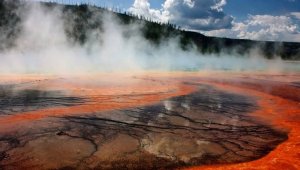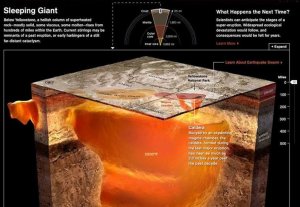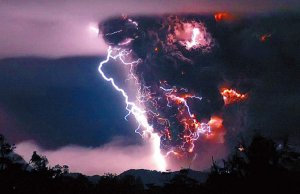

If you’ve heard of Yellowstone National Park then, chances are, you’ve heard doomsday scenarios about Yellowstone National park. The 2005 movie “Supervolcano” highlights how these scenarios generally play out: Yellowstone erupts; people are drowned beneath mountains of lava; a looming cloud of sulfur dioxide gets carried over the globe; the Earth plunges into a volcanic winter; we all die.
Fun times…
Now I hope that you don’t get your science facts from movies, but the thing is, people aren’t just talking about a Yellowstone super eruption in movies. So let’s get the facts.
In truth, Yellowstone is quite massive…and so is its underground magma reservoir. At 3,472 square miles (8,987 square km), the park is larger than Rhode Island and Delaware combined. And as we all know, a portion of the park sits on top of a giant volcanic caldera (a “caldera” is an earthen cap that covers a huge reservoir of magma). Like the rest of the park, the underground magma chamber is larger. It’s about 37 miles long (60 km), 18 miles wide (30 km), and 3 to 7 miles deep (5 to 12 km).
That may sound rather terrifying; however, fortunately for us, all that magma is tucked safely beneath the surface of the Earth. But what if it wasn’t? What if Yellowstone erupted? Would the Earth be plunged into a volcanic winter, as some sources indicate?

Geologist Jake Lowenstern (scientist-in-charge of the Yellowstone Volcano Observatory) has the answers that we seek. According Lowenstern, although the Yellowstone magma source is enormous, walls of lava won’t come pouring across the continent if there’s a super eruption. Instead, the lava flows would be limited to a 30-40 mile radius. Of course, this is still widespread enough to cause significant devastation. There would be no hope for any life forms living within this radius, and the surrounding areas would be engulfed in flames—forest fires would likely rage out of control…but a majority of the immediate damage would be contained within the surrounding area.
Most of the long-range damage would come from “cold ash” and pumice borne on the wind. 4 or more inches (10 cm) would cover the ground in a radius of about 500 miles. This would prevent photosynthesis and destroy much of the plant life in the region. Lighter dustings would traverse the United States– polluting farms in the Midwest, covering cars in New York, and contaminating the Mississippi River. It would clog waterways and agricultural areas with toxic sludge. Thus, the worst outcome of this event would be the destruction of our food supplies and waterways.
It’s likely that we’d see a global effect on temperatures from all the extra particles in the Earth’s atmosphere. However, and this is the key, these effects would only last a few years as Yellowstone isn’t nearly big enough to cause the long-term catastrophes that we see play out in doomsday scenarios (so no need to worry about a new ice age).

Photograph by Carlos Gutierrez/UPI/Landov via National Geographic
Moreover, contrary to what Hollywood would have you believe, the eruption won’t come without warning.
A super eruption, like all volcanic eruptions, begins with an earthquake. And if Yellowstone were to have a super eruption, we’d have some big ones. These earthquakes would begin weeks or months before the final eruption. So this eruption wouldn’t come out of nowhere.
In fact, most scientists agree that such an eruption won’t come at all as the caldera has gone through many regular eruptions that release pressure.
The park has many, many hydrothermal features. It has some 1,000 to 3,000 earthquakes per year. According to the National Park Service, “Current geologic activity at Yellowstone has remained relatively constant since scientists first started monitoring more than 30 years ago. Another caldera-forming eruption is theoretically possible, but it is very unlikely in the next thousand or even 10,000 years. Scientists have also found no indication of an imminent smaller eruption of lava.” (emphasis mine). On top of this, the University of Utah Seismograph Station tracks this activity closely.
So it seems that you can add “A Yellowstone Super Eruption” to your list of ways that the world will not end (Yay!). I don’t know where CNN gets their titles from, but it’s certainly not a scientific authority.